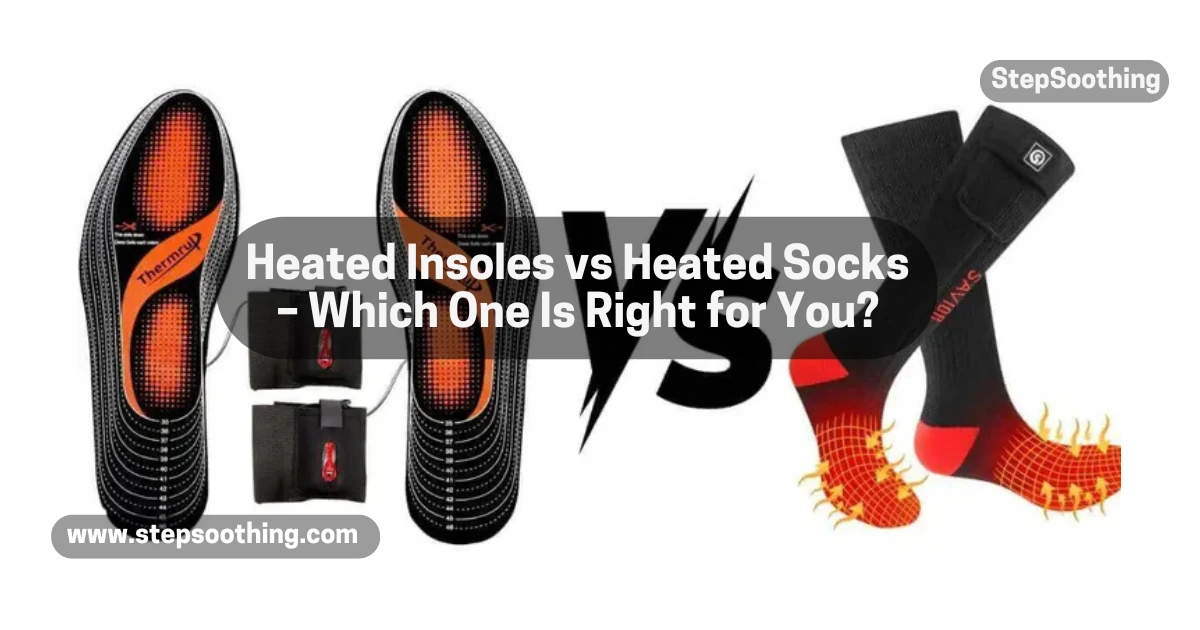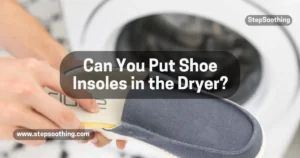When winter hits and the chill is unbearable, keeping your feet warm becomes a top priority. Many people face the struggle of staying warm outdoors, especially when dealing with cold conditions. This has sparked a debate on whether heated insoles or heated socks are the better choice. Both options aim to keep your feet toasty and comfortable, but each has its own set of benefits and challenges. Let’s dive into the key differences to help you decide which is the better option for your needs.
Heated Insoles vs Heated Socks – Which Provides Better Warmth and Comfort?

What are Heated Insoles and Heated Socks?
What are heated insoles and how do they work? Heated insoles are designed to generate heat using built-in heating elements placed inside the sole of your footwear. They focus on providing warmth to the bottom of your foot, directly combating the coldness that can make your toes and entire feet feel frozen.
On the other hand, heated socks feature integrated heating wires within the fabric, providing warmth across the entire foot and sometimes the calf. Both insoles and socks work to keep your feet warm, but their structure and heat distribution differ, making each suitable for different footwear and activities.
How do Heated Insoles and Heated Socks work technically?
Both heated insoles and heated socks are powered by batteries, though the type of power source can vary. Battery-powered or USB-rechargeable versions are common in both products. The heating elements are placed strategically inside the insoles or within the fabric of the socks to ensure optimal heat distribution.
Heated insoles focus primarily on warming the bottom of the foot, while heated socks spread warmth across the entire foot and sometimes the calf. The controls for adjusting the heat can vary too, with some models offering a remote or app-based system, while others rely on manual buttons.
If you’re wondering, Can I adjust the temperature settings on heated insoles? yes, most modern models allow you to choose different heat levels depending on the temperature and your activity.
Pros and Cons of Heated Insoles
✅ Pros:
- Heated insoles provide direct heat to the bottom of the foot, making them an excellent option for those who suffer from cold feet.
- They are compatible with any socks, allowing you to wear them in regular shoes without any altering of your usual footwear.
- Since heated insoles are placed inside your shoes, they are less visible during wear, offering a discreet solution for staying warm.
❌ Cons:
- Heated insoles come with limited fit options and may not work well for all foot shapes.
- Shorter battery life in many cases. Learn more about how long the battery lasts on heated insoles to make an informed decision.
Pros and Cons of Heated Socks
✅ Pros:
- Heated socks provide warmth to the entire foot and sometimes the calf, offering more comprehensive warmth, especially for those who suffer from cold toes.
- The heat is distributed more evenly, ensuring a comfortable warmth across the whole foot.
- Heated socks are perfect for people who prioritize warmth over bulk, especially in extreme cold conditions.
❌ Cons:
- The bulkiness of heated socks can make them difficult to wear with tight-fitting shoes or boots.
- Socks require more maintenance, such as washing, drying, and proper storage, which can be a hassle for everyday use.

Which is better for Different Activities?
| Activity | Heated Insoles | Heated Socks |
| Walking/Hiking | ✅ Lightweight | ❌ Can feel thick |
| Snow Sports | ❌ Less insulation | ✅ Higher heat coverage |
| Static Activities | ❌ Less effective | ✅ Full warmth coverage |
| Commuting | ✅ Easy to use | ❌ Less discreet |
Insights:
For activities like walking or hiking, heated insoles are a great choice as they are lightweight and fit into regular footwear. For snow sports or longer outdoor activities like skiing or snowboarding, heated socks are the better option due to their fuller warmth coverage. Heated socks also offer more effective heat distribution for static activities or long periods of sitting.
Which offers more Comfort and Fit Flexibility?
While heated insoles are generally designed to fit inside existing shoes or boots, they tend to have a fixed shape and less adaptable fit. This means they may not work well with all foot sizes or shapes. On the other hand, heated socks are stretchable, but if the sizing is off, they can become tight, especially around the calf. User feedback indicates that heated socks tend to score higher in comfort when properly sized, offering a snug and warm experience. However, the tight fit can sometimes cause discomfort if not sized properly.
Battery life and Charging time compared
| Product Type | Avg. Battery Life | Charging Time | Heat Settings |
| Heated Insoles | 3–5 hours | 3 hours | 2–3 modes |
| Heated Socks | 5–8 hours | 4 hours | 3–4 modes |
Heated socks generally have a longer battery life, lasting 5–8 hours, compared to heated insoles which typically last only 3–5 hours. Heated socks also tend to offer more heat settings, giving users more control over their warmth. However, heated insoles may be quicker to charge and require less maintenance when it comes to battery management.
As you evaluate, consider checking how long the battery lasts on heated insoles, especially if you’re planning extended use.
Which is more durable in the long run?
When it comes to durability, heated insoles tend to have the edge due to their abrasion-resistant sole materials, which are built to withstand wear and tear. Heated socks, however, are made from durable knit fabrics but require more frequent maintenance, especially with regard to washing and drying. Proper care, such as moisture management, is essential to ensure the longevity of both products. Battery life is another crucial factor, with heated insoles generally having shorter battery lives than heated socks, but the batteries in heated insoles may last longer with proper care.
What do users and experts say?
Reviews from users who enjoy outdoor activities like hiking, skiing, and cycling often note the superior warmth and comfort provided by heated socks during long days outdoors. Experts emphasize the benefits of both options for improving blood circulation and alleviating the discomfort associated with cold feet, especially for individuals suffering from neuropathy or conditions like Raynaud’s syndrome. For everyday use, heated insoles are often seen as a more versatile option, especially for people who already own high-quality boots and shoes.
How much do they cost and are they worth it?
Heated insoles generally range from €40 to €150, while heated socks fall between USD 30 and USD 120. The price of both products varies based on features such as battery life, heating technology, and comfort. When comparing the value-for-money, heated socks may be a better option for those seeking full coverage, while heated insoles may be more cost-effective for people who already own good-quality footwear.
Heated Insoles or Heated Socks – Which Should You Choose?
Your ultimate decision between heated insoles and heated socks depends on various factors, including the type of activity, your personal preferences, and your budget. If you need more extended warmth for outdoor adventures or have cold toes, heated socks might be the better option. However, if you’re seeking a comfortable, versatile, and less bulky solution, heated insoles might be the go-to choice.
Visual Comparison Chart: Heated Insoles vs Heated Socks
| Feature | Heated Insoles | Heated Socks |
| Warmth Coverage | Bottom of foot only | Entire foot, toes, sometimes calf |
| Fit Flexibility | Less flexible, fixed shape | Stretchable, snug fit |
| Battery Life | 3–5 hours (average) | 5–8 hours (average) |
| Charging Time | ~3 hours | ~4 hours |
| Best for | Walking, commuting, daily wear | Winter sports, long hours in the cold |
| Visibility | Discreet, hidden inside footwear | Can be bulky in tight shoes |
| Durability | Generally more rugged | Depends on washing care |
| Maintenance | Wipe clean | Requires gentle wash & air dry |
| Transferability | Can move between different shoes | Not transferable—one pair per use |
| Ease of Use | Drop-in and go | Requires proper fit and battery setup |
| Price Range | €40–€150 | USD30–USD120 |
Top Product Recommendations for Heated Insoles & Heated Socks
Thermrup Electric Heated Insoles

The Thermrup Electric Heated Insoles are a go-to solution for individuals who spend extended hours outdoors in cold environments. Designed with USB rechargeable technology and a remote control system, these insoles offer convenience and adaptability. Whether you’re hiking in snowy trails or commuting on icy mornings, their powerful heating elements provide consistent warmth to the sole of your foot, reducing the risk of cold-related discomfort or stiffness. Their rugged construction ensures durability and long battery life, making them ideal for demanding outdoor conditions.
These electric foot warmers are highly favored by winter hikers and workers who need dependable warmth without sacrificing comfort. Unlike bulky alternatives, Thermrup insoles fit neatly into most types of footwear without creating pressure points. Users appreciate the quick heat-up time and ease of operation, especially in freezing weather. With adjustable settings and reliable battery performance, they’re among the best thermal foot support solutions available today.
SNOW DEER Wireless Heated Insoles

The SNOW DEER Wireless Heated Insoles are engineered for people with active lifestyles who demand both performance and comfort. Featuring adjustable temperature settings, these insoles cater to personalized warmth needs, whether you’re trail running, cycling in winter, or navigating cold urban streets. The slim-fit design allows them to be used seamlessly in both athletic and casual footwear, giving them an edge in versatility over traditional foot warmers.
In terms of user-friendliness, SNOW DEER insoles stand out with their wireless remote control and consistent heat distribution across the entire footbed. This makes them especially beneficial for individuals dealing with cold feet, poor circulation, or Raynaud’s syndrome, as the gentle heat helps stimulate blood flow. Their lightweight construction doesn’t compromise shoe fit, making them a preferred choice for anyone needing heated insoles for hunting, sports, or everyday use.
Savior Heat Heated Socks

The Savior Heat Heated Socks are purpose-built for cold-weather adventures like snowboarding, hunting, and winter hiking. They offer excellent heat distribution across the entire foot, including the toes and heel, which are the most vulnerable areas in freezing temperatures. Designed with outdoor performance in mind, these battery heated socks provide hours of reliable warmth, making them ideal for long periods of exposure to cold.
Comfort is another standout feature of Savior Heat socks. With soft, breathable materials and an ergonomic fit, they remain comfortable even during intense physical activity. Their durability makes them a top pick for those who engage in outdoor winter sports, while the heat zones ensure consistent thermal support. They’re a go-to for people who need full-foot coverage without bulk, providing a practical balance of performance, comfort, and longevity.
Fieldsheer Bluetooth Heated Socks

The Fieldsheer Bluetooth Heated Socks bring smart technology into winter wear, allowing users to control heat levels through a smartphone app. This smart temperature control system is perfect for fine-tuning comfort based on your activity—whether you’re walking, skiing, or sitting outdoors. These socks also excel in moisture management, wicking away sweat and keeping your feet dry and warm, a critical feature for avoiding frostbite and discomfort.
Loved by users with Raynaud’s syndrome, neuropathy, or chronic cold feet, these socks provide therapeutic warmth that enhances blood circulation. Their thoughtful design includes long-lasting batteries, reinforced stitching, and seamless heating elements that don’t feel bulky inside your boots. For people seeking high-tech, moisture-wicking heated socks, Fieldsheer offers a premium solution with maximum control and comfort.
Frequently Asked Questions
Can you wash heated socks?
Yes, most heated socks are washable, but it’s essential to follow the manufacturer’s instructions. Usually, you need to remove the battery, use a delicate, low wash setting, and air dry them completely before reuse. Avoid bleach, harsh chemicals, and tumble drying to ensure longevity and maintain moisture management.
Are heated insoles safe for diabetics?
Heated insoles can be beneficial for people with diabetes, especially those who suffer from neuropathy or poor blood circulation. However, they must be used cautiously. Always check for any burns, overheat risks, or direct contact with the skin, and choose models with temperature control and safety features. Consulting a healthcare provider is strongly recommended before use.
How long do heated socks last?
The lifespan of heated socks depends on the quality, battery, and how well they’re maintained. On average, they last several seasons with proper care, and some high-end models can deliver consistent warmth for over 11 hours per charge. Durability varies by brand, so choosing high-quality, wear-resistant materials is key.
Can you wear both heated insoles and socks at once?
Technically, yes—you can layer heated insoles with heated socks for extreme cold conditions, but this setup may feel tight, especially in snug footwear. Also, consider battery placement, comfort, and safety. Most users find that using one device effectively meets their needs without doubling up.



